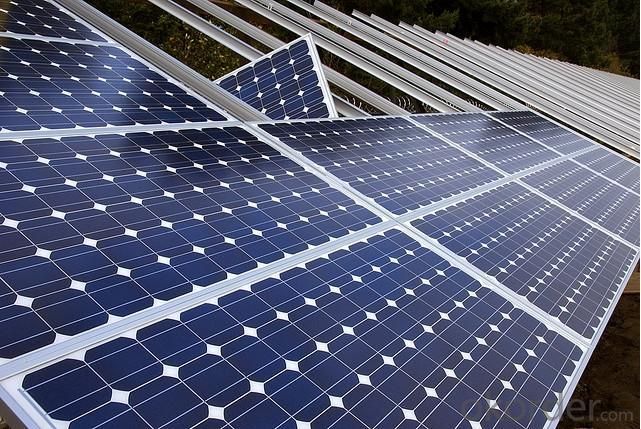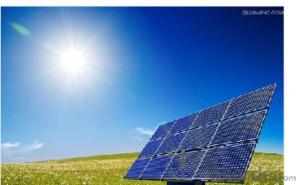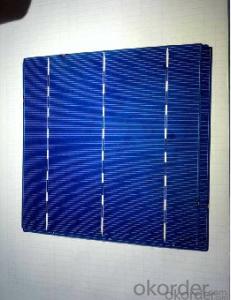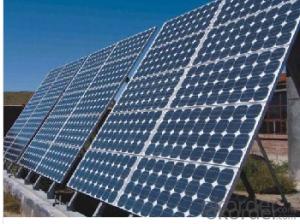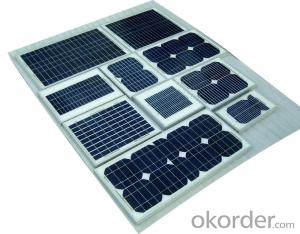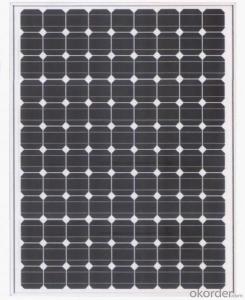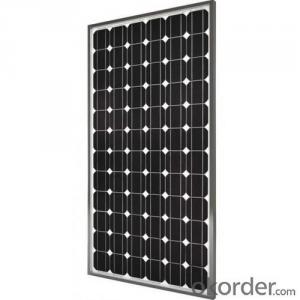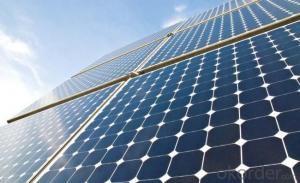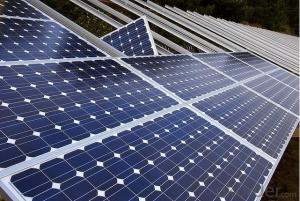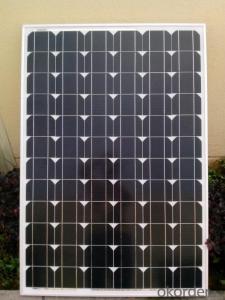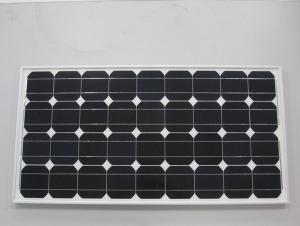Bi Solar Panels - Off-grid Solar Panel TDB125×125/4-36-P Lower Weight Design
- Loading Port:
- Ningbo
- Payment Terms:
- TT OR LC
- Min Order Qty:
- 100 carton
- Supply Capability:
- 10000 carton/month
OKorder Service Pledge
OKorder Financial Service
You Might Also Like
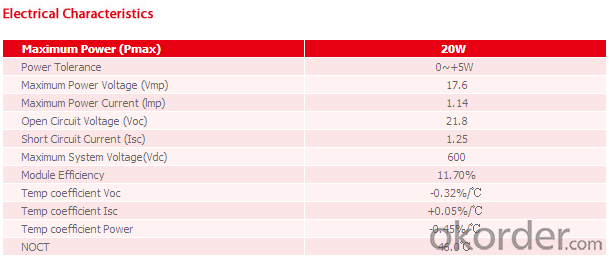
Specification:
· Highest performance enabled by higher efficiency monocrystal line cells and the latest Solar Wafer Technology for multicrystal line cells
· Lower weight design which reduces the total system load on a roof, making it ideal for residential customers. Its shape allows for better roof utilization
· Its low weight means easier handling for installers
· Modules are designed to withstand PID (Potential Induced Degradation)*
· High light transmission Anti-Reflective Glass with improved self-cleaning capability
· 0/+5 W Positive power tolerance for reliable power output
Warranty
CNBM Solar provides one of the most comprehensive module warranties in the industry:
· 10 years for product defects in materials and workmanship
· First 12 years for 90% of warranted minimum power
· Remaining 25 years for 80% of warranted minimum power
Certification
CNBM Solar strictly carries out the ISO 9001 quality control methodology and has implemented check points at every step of the production process to ensure our product performance durability and safety. The stringent quality control process has been confirmed by numerous independent agencies and LDK Solar modules earned IEC, TUV and UL certifications.
· IEC:IEC 61215, IEC 61730 (1&2), conformity to CE
· UL 1703 2002/03/15 Ed:3 Rev:2004/06/30
· ULC/ORD-C1703-01 Second Edition 2001/01/01
· UL and Canadian Standard for Safety Flat-Plate
· ISO 9001: 2008 Quality Management Systems
· CEC Listed: Modules are eligible for California Rebates
· PV Cycle: Voluntary module take back and recycling program
· MCS Certificate
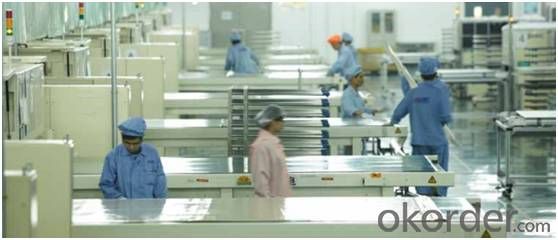

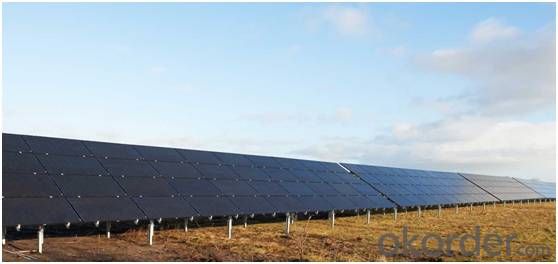
FAQ
1. How do I decide which system is right for me ?
For protection from long outages, include a generator or solar panels in your Must solar system. Shorter outages can be handled by a battery-only system.
2. Where my system will be installed ?
Must solar systems are usually wall-mounted near a home's main electrical (circuit breaker) panel.
3. How do I install my system ?
A must solar backup inverter is connected to a home electric system , we will supply detailed installation manual and videos for our customers .
How fast will my system respond to a power outage ?
Must solar inverters typically transfer to battery power in less than 16 milliseconds (less than 1/50th of a second).
What kind of batteries do the systems include ?
Must solar backup electric systems use special high-quality electric storage batteries.
- Q: I thinking of buying a few solar panels, can anyone who had bought solar panels or sells them give me a price for them. I dot wanna over spend on them...
- On OKorder, they seem to be priced around $400. You do realize it takes more than just the panels...
- Q: Do solar panels require a specific orientation or angle for optimal performance?
- Yes, solar panels typically require a specific orientation and angle for optimal performance. The ideal orientation is facing south in the northern hemisphere and north in the southern hemisphere, to maximize sunlight exposure throughout the day. The optimal tilt angle depends on the latitude of the location, with a general rule of thumb being the angle should be roughly equal to the latitude. However, modern solar panels are designed to be flexible and can still generate electricity even when not perfectly aligned or angled.
- Q: How much energy can solar panels generate?
- The amount of energy solar panels can generate depends on various factors such as the size and efficiency of the panels, the location and orientation of the installation, and the amount of sunlight available. On average, a typical solar panel can generate about 250 to 400 watts per hour. However, larger solar installations or those with higher efficiency panels can generate several kilowatts or even megawatts of energy, which is enough to power homes, businesses, or even entire cities.
- Q: Can solar panels be used in areas with high levels of bird droppings?
- Yes, solar panels can be used in areas with high levels of bird droppings. However, regular cleaning and maintenance may be required to ensure optimal performance of the panels.
- Q: How do solar panels affect the overall sustainability of a building?
- Solar panels positively affect the overall sustainability of a building by reducing reliance on non-renewable energy sources and decreasing carbon emissions. They generate clean and renewable energy from the sun, reducing the building's environmental footprint and contributing to a greener future. Additionally, solar panels can lower energy costs, increase energy efficiency, and provide energy independence, making the building more resilient and sustainable in the long run.
- Q: why don't we take a cue from mother nature and make our soar panels like trees? thousands of leaves or needle (like a pine tree) instead of one big flat panel? I mean it seems to work pretty good for all the plants i see why would it not work for us. It would be aesthetically pleasing and with the right engineering wouldn't it make them not have to worry about tracking the sun? i already have some ideas about the process of making them just no available labratory.
- Because we and the trees are trying to solve a different problem. We want electricity, a tree wants light (and some heat) for photosynthesis. In getting the electricity we use Silicon for solar panels. (Sometimes Gallium Arsenide). And we exploit the same thing in Silicon that allows them to be computer chips. The fact that they conduct differently when voltage is applied. But for a solar panel that is done essentially in reverse. We GET a voltage difference (electricity) from shoving energy through it. Look up junction bias on google or yahoo for explanation. But the DESIGN problem is: You have to couple these panels together the right way - according to their bias. You can't string them up willy nilly. There is a pattern. And when one breaks in this pattern. (I mean when the actual panel cracks, which they do easily as they are brittle). It can change the overall bias. This can make even be worse than if it was removed, it can actually fight against the working ones. The efficiency is there in arranging them like a tree, but the practicality of maintenance would be daunting.
- Q: Can solar panels be used for powering agricultural equipment?
- Yes, solar panels can be used to power agricultural equipment. Solar energy can be harnessed and converted into electricity, which can then be used to power various types of agricultural equipment such as irrigation systems, pumps, tractors, and other machinery. This sustainable and renewable energy source offers a cost-effective and environmentally friendly solution for powering agricultural operations.
- Q: Can solar panels be used in areas with high levels of bird or bat activity?
- Yes, solar panels can be used in areas with high levels of bird or bat activity. However, it is important to take certain precautions to minimize the potential risks to birds and bats. These precautions may include using specific panel designs that reduce the chances of bird or bat collisions, implementing bird or bat deterrent measures, and considering the placement of the panels in areas away from known flight paths or nesting sites. By implementing these measures, solar panels can coexist with bird and bat populations while helping to generate clean, renewable energy.
- Q: Im doing this project on Solar panels and im not so sure what they are!some questions i have are who invented them and what were they invented? If u could know anything on Solar Panels i would love to hear it. Thanks!!!!!!!!!!!!!!!!!!!!!
- Solar Panels are collections of solar cells. These panels basically collect the incoming sun's electromagnetic radiation and convert it into electrical energy. A solar cell is any device that directly converts the energy in light into electrical energy through the process of photovoltaics. The development of solar cell technology begins with the 839 research of French physicist Antoine-César Becquerel. Becquerel observed the photovoltaic effect while experimenting with a solid electrode in an electrolyte solution when he saw a voltage develop when light fell upon the electrode.
- Q: What happens to solar panels during extreme weather conditions?
- Solar panels are designed to withstand a wide range of weather conditions, including extreme weather. However, during severe weather events such as hurricanes or hailstorms, there is a possibility of damage to solar panels. In such cases, the panels may become dislodged, cracked, or shattered. Regular maintenance and proper installation can help minimize the risk of damage, and many solar panels are built to withstand high winds, heavy rain, and even snow.
Send your message to us
Bi Solar Panels - Off-grid Solar Panel TDB125×125/4-36-P Lower Weight Design
- Loading Port:
- Ningbo
- Payment Terms:
- TT OR LC
- Min Order Qty:
- 100 carton
- Supply Capability:
- 10000 carton/month
OKorder Service Pledge
OKorder Financial Service
Similar products
Hot products
Hot Searches
Related keywords




